| Columns Retired Columns & Blogs |
They look like the head from ZARDOZ.
I used DRA Labs' MLSSA system (www.mlssa.com) and a calibrated DPA 4006 microphone to measure the GoldenEar Aon 2's frequency response in the farfield, and an Earthworks QTC-40 for the nearfield responses. The Aon 2's voltage sensitivity is specified as an above-average 89dB; my estimate was significantly lower, at 86.2dB(B)/2.83V. The speaker's impedance dips below 6 ohms in the mid-treble and midrange, reaching a minimum value of 3.5 ohms at 190Hz (fig.1). There are also combinations of a lowish magnitude and highish electrical phase angle in two regions: 100–150Hz and 3–4kHz. However, a receiver or amplifier specified for 4 ohms will have no difficulty driving the Aon 2.
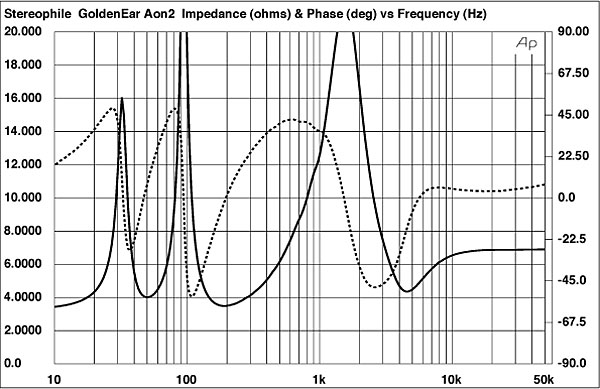
The traces in fig.1 are free from the small discontinuities that would hint at the presence of cabinet resonances of some kind. In fact, the only significant resonant mode I found was on the plastic trim panel on the enclosure's top (fig.2). This behavior is undoubtedly benign.
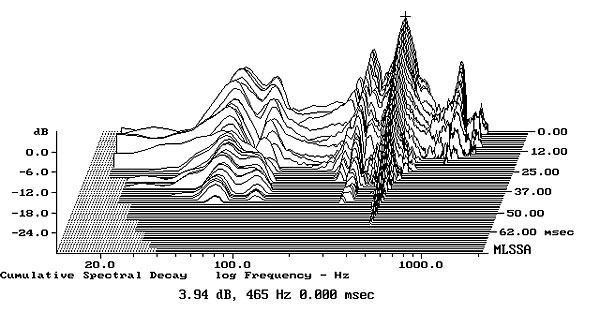
The saddle centered on 50Hz in the impedance-magnitude trace suggests that this is the tuning frequency of the twin side-mounted passive radiators. However, the woofer's nearfield response (fig.3, blue trace) shows that driver's minimum-motion notch—ie, where the cone is held still by the back pressure of the passive-radiator resonance—to be slightly lower in frequency, at 48Hz. The passive radiators, which behave like a conventional reflex port, have a wider passband than usual (fig.3, red), with a lower-than-usual low-pass rollout slope. The complex sum of the nearfield outputs (fig.3, black trace) peaks by almost 10dB in the upper bass. This will be due in part to the nearfield measurement technique, which acts as if the drive-units were mounted in a baffle extending to infinity in all directions. However, the Aon 2's low-frequency alignment is underdamped, presumably to give the impression that it is producing more bass than would or should be expected from so small a speaker—which is what BJR found: "the Aon 2's lower midrange had a warm richness that made it sound like a much larger speaker," and its "low-end extension and naturalness through the midbass also suggested a larger, more expensive speaker."
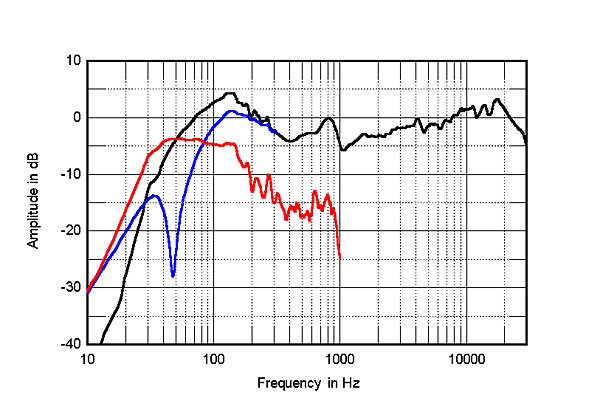
Higher in frequency in fig.3, the Aon 2's response had a peak in the upper midrange, followed by a dip. This kind of response is often associated with a nasal coloration, though BJR didn't note any such character. However, he did comment that the Aon 2's high frequencies were more extended than those of the three speakers with which he compared it. The Aon 2's farfield response (fig.3, black trace above 1kHz) does indeed show a slight rising trend all the way to 20kHz. This will not be ameliorated by the usual drop-off in top-octave response to the speaker's sides, as the Aon 2's plot of lateral dispersion (fig.4) indicates a wide radiation pattern to above 3kHz. Other than a slight flare in the mid-treble, the contour lines in this graph are smooth and even, something that generally correlates with precise stereo imaging. Vertically (fig.5), a suckout develops at the crossover frequency of 3.5kHz 10° above or below the tweeter axis, though it is more severe below the tweeter. The Aon 2s should be set on stands that place their tweeters level with the listener's ears.
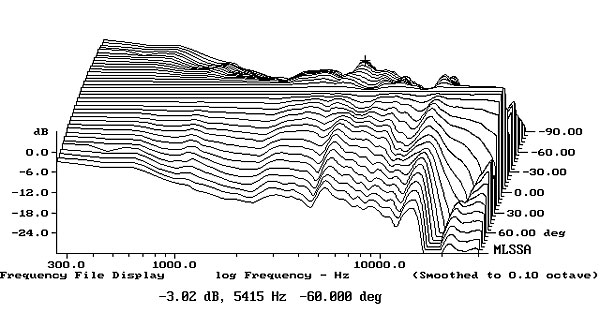
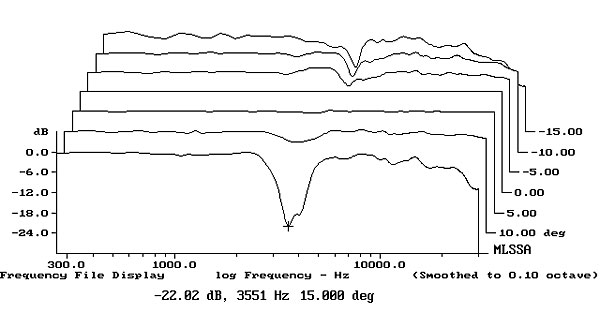
In the time domain, the GoldenEar's step response on the tweeter axis (fig.6) indicates that the tweeter is connected in inverted acoustic polarity, the woofer in positive polarity. However, the decay of the former's step blends smoothly with the start of the latter's, implying similarly good integration of their outputs in the frequency domain. The slight undulations visible in the decay of the woofer's step give rise to some delayed energy at the frequency of the midrange peak on the on-axis response (fig.7). Other than that, the Aon 2's cumulative spectral-decay plot is clean.

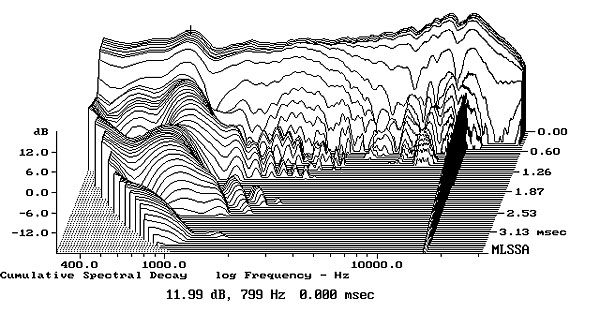
I was a little concerned by the presence of that upper-midrange peak, but the Aon 2 otherwise measures well for its price, as I have come to expect from GoldenEar's Sandy Gross.—John Atkinson

They look like the head from ZARDOZ.

First, I'm thrilled to see someone else has seen the movie Zardoz... and second, that the person had the same reaction I did when seeing the Aons. I had to suppress a snicker the first time I saw the Aon speakers for that reason. Hearing them was amazingly effective in helping me suppress the snicker.
I'm eager to get a pair of Aons for my rear speakers in my video system. I've got Triton Twos for left and right, and a SuperSat 60 center. I tried Supersat 50s for the rear left and right and they didn't have bass needed - the video setup is in a high ceilinged, large family room/dining area location, and without good bass in the rear, the subwoofer up front doesn't integrate well. I'm using a non-Goldenear speaker pair for rear right now, with good bass, and they integrate very well other than the treble isn't as crystaline as it is from the front. So there will be Aon rear speakers in my future - by process of elimination, clearly the right way to go.

I wasn't saying that was a bad thing! But if they start blurting out "THE GUN IS GOOD" then I might be a bit worried.

I don't know many people who care about audio systems, let alone mine. I do know people who care about music.
Went to the University symphony again last night. (They're very good, considering it was a free concert.) Sat row 7, center. Once again I recalibrated, realizing how warm and loud live music is and how much deep bass a symphony produces. Also, surprisingly little imaging or spatial cues. Rather, immense, enveloping physical impact. A lot like good mono classical albums.
I value these recalibrations. Makes me realize the gap between "hi-fi" and live music. Makes me appreciate mono, lush midrange and alarmingly clear bass. (This, of course, doesn't apply to a lot of modern electronic music which is engineered for ultra hi-fiy sounding systems.)
I can't afford and have few people to impress with expensive audio jewelry. So, I value reviews such as this. Good, affordable gear that gets out of the way of real music.
Thanks again, Stereophile.

Has anyone compared GoldenEar Technology Aon 2 to Sjöfn HiFi's "The Clue" speakers (around the same price) or Magnepan Super MMG?
I am particularly interested to know which one delivers more realism.
Thanks

I heard the Aon 2 in two different hi-fi stores and came out disappointed both times.
One retailer hooked these up to SimAudio components. After demoing these, he hooked up Dynaudio Emit 10 and I was blown away by the Dynaudio.
The 2nd time, the retailer played an audio CD from an Oppo player hooked up to a McIntosh stereo receiver. These were dwarfed by the Triton 5, however the margin of victory was too great. It seemed as if Aon 2's were from a different manufacturer altogether.
I think your readers deserve a comparison between the Emit M10 and the Aon 2. In this case, these GoldenEar speakers have received acclaim which they don't deserve, in my humble opinion.
Regardless of your opinion on the Dynaudio, your readers probably deserve to know what you think.
Respectfully yours,
A concerned audiophile